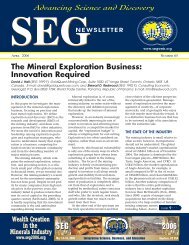Stewart R. Wallace — 1919–2009 - Society of Economic Geologists
Stewart R. Wallace — 1919–2009 - Society of Economic Geologists
Stewart R. Wallace — 1919–2009 - Society of Economic Geologists
You also want an ePaper? Increase the reach of your titles
YUMPU automatically turns print PDFs into web optimized ePapers that Google loves.
16 SEG NEWSLETTER No 78 JULY 2009<br />
... from 15<br />
base-metal sulfides in deeper ore<br />
(Wagner, 1929). Some areas were trial<br />
mined, but low metal prices in 1929<br />
resulted in closure <strong>of</strong> most operations in<br />
the Bushveld, including those on the<br />
pipes. The one exception was Kroondal,<br />
where mining <strong>of</strong> the thin yet extraordinarily<br />
high grade Merensky reef (ore<br />
was hand sorted prior to milling)<br />
proved to be viable (Wagner, 1929).<br />
THE PGE DEPOSITS<br />
Discovery and Geology <strong>of</strong> the PGE Deposits <strong>of</strong> the Bushveld Complex, South Africa (Continued)<br />
The UG2 reef<br />
The UG2 reef is a textbook example <strong>of</strong> a<br />
stratiform deposit: mineralization is<br />
constrained to a layer <strong>of</strong> chromitite,<br />
albeit locally with one or more barren<br />
partings <strong>of</strong> feldspathic orthopyroxenite,<br />
which may vary from a few centimeters<br />
to several meters thick (Fig. 5A). The<br />
UG2 is persistent in some sectors <strong>of</strong> the<br />
eastern and western limbs for tens <strong>of</strong><br />
kilometers along strike and to depths <strong>of</strong><br />
at least several kilometers. The footwall<br />
and hanging-wall rock units reveal considerable<br />
lateral variation, but, typically,<br />
the chromitite occurs in association with<br />
feldspathic orthopyroxenite and noriteanorthosite.<br />
Mining <strong>of</strong> a narrow reef,<br />
particularly in high tonnage operations,<br />
is a specialized business and in the case<br />
<strong>of</strong> the UG2 is exacerbated by problems<br />
caused by potholes (Lomberg et al.,<br />
1999), areas from a few meters to several<br />
hundreds <strong>of</strong> meters in diameter<br />
where part <strong>of</strong> the footwall sequence is<br />
absent. Dilution resulting from hanging-wall<br />
collapse due to planes <strong>of</strong> weakness<br />
associated with thin chromitite<br />
stringers (“leader seams”) is an additional<br />
problem.<br />
Ore reserve calculations, excluding<br />
losses due to potholes and dilution, are,<br />
however, relatively simplistic, despite<br />
evidence <strong>of</strong> a pronounced nugget effect.<br />
The double peak <strong>of</strong> mineralization (bottom<br />
and either middle or top loaded,<br />
depending on layer thickness) is persistent<br />
throughout the intrusion, and is<br />
defined by total PGE and interelement<br />
ratios (Hiemstra, 1986). The antipathetic<br />
relationship between grade and<br />
thickness has been widely remarked<br />
upon (e.g., Viljoen and Schurmann,<br />
1998). The footwall lithology <strong>of</strong> the UG2<br />
varies from anorthosite, leuconorite, or<br />
orthopyroxenite to pegmatoidal feldspathic<br />
pyroxenite. Minor amounts <strong>of</strong><br />
PGE are located in the footwall, specifically<br />
if it is pegmatoidal, but are typically<br />
directly associated with disseminations<br />
or stringers <strong>of</strong> chromitite. The<br />
irregular basal contact <strong>of</strong> the chromitite<br />
FIGURE 5. Vertical pr<strong>of</strong>iles <strong>of</strong> some typical reefs: (A) UG2 reef from the Marula mine,<br />
Winnaarshoek; (B) Merensky “thin-reef” from the Brakspruit section, Rustenburg Platinum<br />
mine (after Viljoen and Hieber, 1986); (C) Merensky “wide-reef” from the Marula mine,<br />
Winnaarshoek.<br />
when the footwall is pegmatoidal contrasts<br />
sharply with the planar upper<br />
contact. The chromitite layer may be<br />
thinner in areas where the pegmatoid<br />
contains abundant chromitite, an<br />
observation the authors have made at<br />
the Crocodile River mine, where large<br />
areas <strong>of</strong> the UG2 are underlain by leuconorite.<br />
The grade <strong>of</strong> the UG2 is typically<br />
4 to 8 g/t PGE+Au. The content <strong>of</strong><br />
base-metal sulfides is typically very low<br />
(avg






